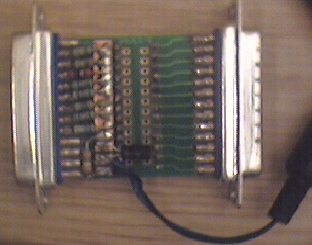Back in the ancient days before sound cards, around 30 years ago, sound cards were rare on PCs. One hack those days was the original Covox Speech Thing, that connected a simple DAC to to PC parallel port. The Covox Speech Thing (also known as Covox plug) was an external audio device attached to the computer to output digital sound. I made same early fame in BBSs when I published my easy to build version of that thing. You can read my story from My LPT DAC story posting.
This was then and nowadays PCs are so different that those old tricks do not work anymore? Or is it really so. Hackaday posting Making A Covox Speech Thing Work On A Modern PC tells that [Yeo Kheng Meng] had heard of this device, and wondered what it would take to get it running again on a modern Linux computer. So he found out in the best possible way: by doing it. His A Science Project: Bringing the Covox Speech Thing to 2017 article tells how to build this old piece of hardware and see if it is possible to get it working on modern systems.

7 Comments
Tomi Engdahl says:
A Science Project: Bringing the Covox Speech Thing to 2017
http://yeokhengmeng.com/2017/01/a-science-project-bringing-the-covox-speech-thing-to-2017/
Tomi Engdahl says:
Silly Sound Bastard: yet another Covox Speech Thing clone
https://www.youtube.com/watch?v=DKLKtH_rQJU
Yet another Covox Speech Thing clone.
Project Sources:
https://github.com/necroware/silly-sound-bastard
Covox device theory by Eugeny Brychkov:
http://kb.gr8bit.ru/KB0010/GR8BIT-KB0010-Adding-multimedia-capability-covox-device.html
Audio Tracks:
https://modarchive.org/index.php?request=view_by_moduleid&query=35339
https://modarchive.org/index.php?request=view_by_moduleid&query=40475
Tomi Engdahl says:
How the Covox and Disney Sound Source Worked.
https://www.youtube.com/watch?v=Wt4VcLF8Wug
In this episode I explore the Covox Speech Thing and Disney Sound Source.
Tomi Engdahl says:
Amiga Samplers : Budget dance music in 1990
https://www.youtube.com/watch?v=i9MXYZh1jcs
An Amiga 500, Stereo Master and handful of $1 records from a 1990 Sunday market: Can we make a dance track on a budget home computer? Of course! Back when big-name dance tunes required big-budget-gear, a secondhand Amiga let you take the first steps to making a dance-floor banger.
Tomi Engdahl says:
https://hackaday.com/2024/06/21/tiny-tapeout-4-a-pwm-clone-of-covox-speech-thing/
Tomi Engdahl says:
https://yeokhengmeng.com/2024/06/my-first-chip-with-tiny-tapeout-cvx/
Tomi Engdahl says:
The ADC0804 is an 8-bit analog-to-digital converter (ADC) that converts analog voltage signals into equivalent 8-bit digital values. It operates on a single 5V power supply and provides an output in binary form ranging from 00000000 (0V) to 11111111 (Vref). The chip uses a successive approximation method for conversion, ensuring high accuracy and fast response. It includes important pins such as Vin(+), Vin(–), Vref/2, clock input, and digital outputs (D0–D7). The reference voltage (Vref) determines the input range; if Vref = 5V, each bit represents 19.53mV. In the circuit shown, an external RC network generates the clock signal, and the ADC interfaces directly with a microcontroller (MCU) to send converted data for further processing. This makes it ideal for sensor-based data acquisition, embedded systems, and measurement applications.
#ElectronicsEducation #electronics #ADC0804 #embedded #microcontroller #electronicsprojects #analog #digital #sensor #adc #engineering